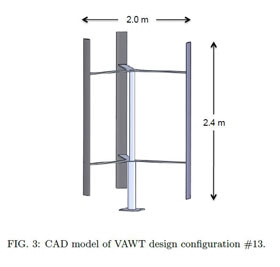Aug 7 2017
The U.S. Department of Energy has made a prediction that by the year 2030, wind energy could provide 20% of electricity in the U.S. This has driven Researchers from the University of Utah’s Department of Mechanical Engineering to examine the performance capabilities and financial advantages of vertical axis wind turbines (VAWTs) in suburban and urban areas.
 Figure 3 illustrates the computer-aided design model for design configuration #13. The turbine blades are assumed to be made of carbon fiber and the turbine shaft and blade supports are made of Aluminum 2024. (Credit: Lam Nguyen and Meredith Metzger, Department of Mechanical Engineering at the University of Utah)
Figure 3 illustrates the computer-aided design model for design configuration #13. The turbine blades are assumed to be made of carbon fiber and the turbine shaft and blade supports are made of Aluminum 2024. (Credit: Lam Nguyen and Meredith Metzger, Department of Mechanical Engineering at the University of Utah)
A VAWT is a wind turbine technology where the generator is vertically oriented in the tower, instead of sitting horizontally on top. While there are a number of VAWT designs, the one used in this research is known as the straight-blade Darrieus type or H-rotor turbine.
According to the Researchers, small VAWTs have the ability to excellently function in the presence of high turbulent flow, which makes them perfect energy harvesting devices in urban and suburban environments.
The Authors present the results in an article in this week’s Journal of Renewable and Sustainable Energy, from AIP Publishing. The results show that an optimally engineered VAWT system can financially contend with fossil-fuel based power plants in urban and suburban areas, and can even spearhead the progress of a net-zero energy building or city.
To determine their results, the team input actual, time-resolved wind speed data into a numerical simulation that determined the total amount of energy absorbed by a turbine throughout the year of operation. Their wind data was accumulated over the year 2009 from 3D sonic anemometers mounted on the top of traffic posts, roughly 9 m, or 30 ft, above ground and placed at nine different urban and suburban sites around Oklahoma City, Oklahoma.
The Researchers simulated 13 types of wind turbine configurations, with a focus on four specific design parameters: blade airfoil shape, turbine solidity, height-to-diameter aspect ratio (H/D) and turbine moment of inertia. The key performance measure used to identify the ideal design configuration was the percent of energy absorbed by the turbine during the course of the year relative to the available energy in the turbulent wind during the same period of time.
Of the 13 design configurations, the ideal turbine design had the least moment of inertia. Interestingly, however, the Researchers established that even with the moment of inertia removed as a design parameter, this configuration was still the most optimal.
They also examined a variety of turbine designs for the levelized cost of energy (LCOE) at one of the test sites and discovered the values for blade features necessary for economically feasible options. The ideal design configuration at this site generated electricity at a cost 10 % lesser than the average national electricity unit price.
This is not the end of our research, and I think that we have more to study on the turbine design configuration and its operating conditions that would allow for enhancing the amount of energy captured by the turbine. […] It’s exciting.
Lam Nguyen, one of the Chief Researchers on the Project
Nguyen is presently expanding his research with a former advisor.
Following their deduction that an optimal design configuration for VAWTs could result in a lower electric cost, the team discerns the work is not over yet.